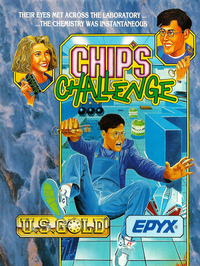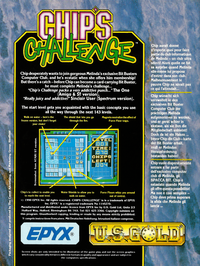Navigation:
Chip's Challenge ZX Spectrum
This game entry is not "published" yet and will not appear in game browers by default! (Edit and set publish = 1)
Chip desperately wants to join gorgeous Melinda's exclusive Bit Busters Computer Club, and he's ecstatic when she offers him membership! But there's a catch - before Chip can become a card-carrying Bit Buster, he must complete Melinda's challenge... — Game Box
Chip's Challenge is a top-down tile-based puzzle video game created in 1989 by Chuck Sommerville originally for the hand-held Atari Lynx. Chip's Challenge was then later ported to multiple formats including the Amiga, Commodore 64, ZX Spectrum, DOS, and Windows, included in the Microsoft Entertainment Pack and Best of Microsoft Entertainment Pack (the last of which was written by Tony Krueger in 1991) . Microsoft licensed Chip's Challenge from Epyx to write a DOS and Windows version of the game; while porting the game, the logic was slightly changed from the original version. It has also been converted to the TI-84+ calculator and the TI-89 Titanium.
The original game was designed and coded by Chuck Sommerville, who also made about a third of the levels.[3] Most of the conversions from the Atari Lynx original to other formats were carried out by Images Software in the UK.
The premise of the game is that high-school nerd Chip McCallahan has met Melinda The Mental Marvel in the school science laboratory and must navigate through Melinda's "Clubhouse" (a series of increasingly difficult puzzles) in order to prove himself and gain membership to the very exclusive Bit Buster Club.
Gameplay
Chip's Challenge consists of a series of 148 two-dimensional levels (149 in Microsoft's version) which feature the player character, Nerdy Chip McCallahan, often called just Chip, and various game elements such as computer chips, buttons, locked doors, water and lethal monsters. Gameplay involves using arrow keys, directional pad or mouse to move Chip about each of the levels in turn, collecting enough chips to open the chip socket at the end of each level, get to the exit, and move on to the next level.
While the same set of rules applies to each level, there are many different kinds of levels. Some are action-oriented and some are puzzle-oriented. Most levels have a time limit. Types of levels include solving a block-pushing puzzle to clear a path, dodging enemies, and moving through a maze. Levels can be skipped by entering an appropriate four-letter non-case-sensitive password. For the PC versions, game progress is automatically saved. If one is having a lot of trouble with a level, the game allows the player to skip to the next level. Progress is measured in terms of completed levels and player score, which is a sum of the scores obtained on each level. Level scores for timed levels can be improved by quickly completing the level, and scores on all levels can be improved by using fewer attempts to complete the level.
Source:Wikipedia


